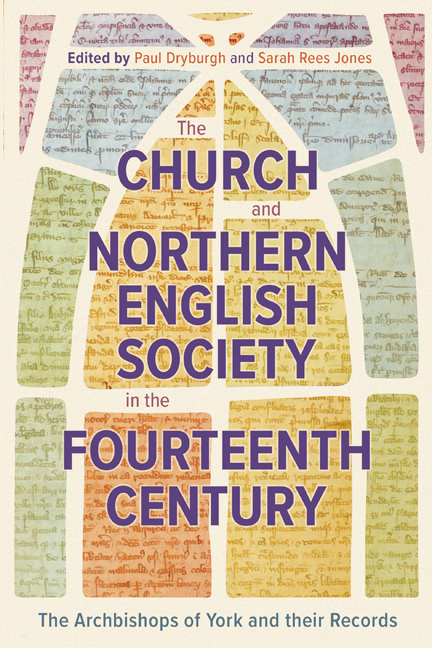 The Church and Northern English Society in the Fourteenth Century
The Church and Northern English Society in the Fourteenth Century Book contents
- Frontmatter
- Dedication
- Contents
- List of Illustrations
- List of Contributors
- Acknowledgements
- List of Abbreviations
- Map: The Ecclesiastical Province of York, c. 1304–1405
- Introduction
- 1 The Administrative Records of the Archbishops of York, 1304–1405
- 2 The Archbishops of York and the Government of Fourteenth-Century England
- 3 Support or Scourge? Archbishop William Melton and the Tradition of Loyal Opposition to the English
- 4 Beyond the Border: The Influence of York Clerks in the Two Edwards’ Scottish Administrations, 1332–1357
- 5 Responding to Royal Requirements: Clerical Taxation in the Province of York, 1304–1405
- 6 Ad insolenciam ipsius rebellis salubrius reprimendam: William Thorntoft, the Abbey of Rufford and Significations of Excommunication in the Northern Province
- 7 Blood, Sex and Holy Water: Reconciling Churches and Churchyards in the Medieval Diocese of York
- 8 Structuring Episcopal Authority: Palaces and Residences of the Archbishop of York
- 9 Medieval Parks of the Archbishops of York
- 10 Northern Ways? Pilgrimage, Politics and Piety in the Fourteenth-Century Administrative Records of the Archdiocese of York
- 11 Underexplored Sources for Gender History: New Approaches to the Fourteenth-Century York Archbishops’ Registers
- 12 Joan of Leeds and other Apostate Nuns in the Province of York, 1300–1350
- Bibliography of Records of the Archbishops of York, 1304–1405
- Index
4 - Beyond the Border: The Influence of York Clerks in the Two Edwards’ Scottish Administrations, 1332–1357
Published online by Cambridge University Press: 17 May 2024
- Frontmatter
- Dedication
- Contents
- List of Illustrations
- List of Contributors
- Acknowledgements
- List of Abbreviations
- Map: The Ecclesiastical Province of York, c. 1304–1405
- Introduction
- 1 The Administrative Records of the Archbishops of York, 1304–1405
- 2 The Archbishops of York and the Government of Fourteenth-Century England
- 3 Support or Scourge? Archbishop William Melton and the Tradition of Loyal Opposition to the English
- 4 Beyond the Border: The Influence of York Clerks in the Two Edwards’ Scottish Administrations, 1332–1357
- 5 Responding to Royal Requirements: Clerical Taxation in the Province of York, 1304–1405
- 6 Ad insolenciam ipsius rebellis salubrius reprimendam: William Thorntoft, the Abbey of Rufford and Significations of Excommunication in the Northern Province
- 7 Blood, Sex and Holy Water: Reconciling Churches and Churchyards in the Medieval Diocese of York
- 8 Structuring Episcopal Authority: Palaces and Residences of the Archbishop of York
- 9 Medieval Parks of the Archbishops of York
- 10 Northern Ways? Pilgrimage, Politics and Piety in the Fourteenth-Century Administrative Records of the Archdiocese of York
- 11 Underexplored Sources for Gender History: New Approaches to the Fourteenth-Century York Archbishops’ Registers
- 12 Joan of Leeds and other Apostate Nuns in the Province of York, 1300–1350
- Bibliography of Records of the Archbishops of York, 1304–1405
- Index
Summary
The Second War of Independence began in 1332 with the invasion of Scotland by Edward Balliol, son of King John Balliol (1292–96). His invasion was supported by Edward III of England, who joined the war in 1333 at the siege of Berwick and funded Balliol's campaigns. In exchange, Balliol granted Edward the southern sheriffdoms of Berwick, Dumfries, Edinburgh, Peebles, Roxburgh and Selkirk, to hold as part of his dominion, and performed homage for the Scottish kingdom. His homage acted as a recognition of Edward III's overlordship of Scotland, while his grant of the sheriffdoms annexed these lands ‘a sa roiale dignite et a son roialme Dengleterre et severez de notre reale dignite et de notre corone Descoce’ (‘to his royal dignity and his realm of England, and severed [them] from our royal dignity and our crown of Scotland’). Therefore, the conflict was a civil and Anglo-Scottish war waged by the two Edwards against the supporters of David II (1324–71), son of Robert Bruce. The Treaty of Berwick in 1357 represented the end of this conflict, ushering in a period of peace for a quarter of a century, although it reached no formal settlement between Edward III and David II. On the contrary, after Balliol renounced the throne to Edward on 20 January 1356, the English king's claim to Scotland was strengthened, and large swathes of the Scottish March remained in English control. Despite the significance of this conflict and the vast territory the two kings controlled for much of the 1330s and 1340s, which spanned from Whithorn to Perth and occasionally farther north, little is known about their administrations of Scotland between 1332 and 1357. While several studies have discussed the governance of Scotland in this period, the two administrations are often discussed in isolation, leading to confusion about which offices belonged to which territory and about the personnel involved. A consequent blurring of offices and roles has meant that the full scale of the two kings’ administrations has not been realised.
By comparison, various aspects of the English administration during the fourteenth century have been well studied by historians.
- Type
- Chapter
- Information
- The Church and Northern English Society in the Fourteenth CenturyThe Archbishops of York and their Records, pp. 128 - 150Publisher: Boydell & BrewerPrint publication year: 2024


